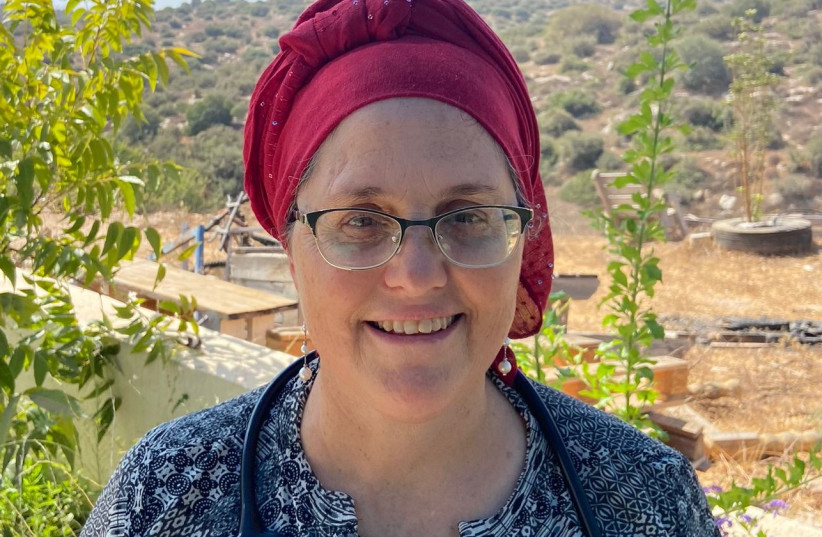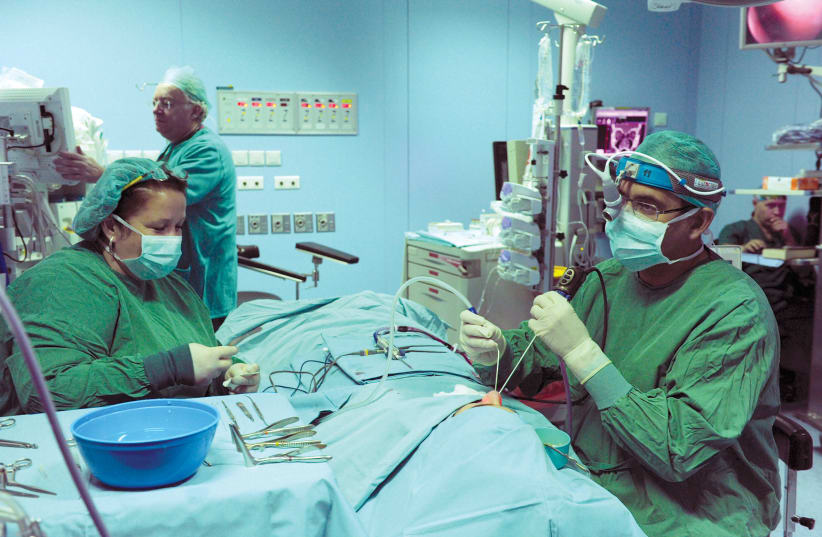
I spent many years in the sheltered ivory towers of Academe, so I am keenly aware of how detached from reality scholars can become.
That is why, as a columnist, I try to heed an Irish friend, Brendan, a veteran management consultant. His mantra is: “Truth is found at the face of the coal mine.” That is, you find truth among those who are the real doers.
The world’s greatest management consultant, Peter Drucker, was famous for rising at 4 a.m. to accompany the vans that brought supplies to Starbucks cafes. Why? You must learn the truth firsthand, he said. You search for it at the coal face.
Israel faces a severe doctor shortage. The doctor I know best is close at hand: our daughter, Dr. Temira Feinsilver, an experienced family physician and medical educator. I asked her about the looming shortage of doctors and nurses and the resulting decision to stop bringing in US and Canadian medical students for training in Israel, to make more room for Israeli medical students.


First, some background.
Many years ago, I did my PhD thesis at Princeton on economic demography. I showed how the US baby boom – the post-World War II spike in births – was like the bulge of a deer in a python’s belly, inevitably, predictably, moving slowly along the python’s body, as the ‘boomers’ aged. Yet each time the baby boomers reached a milestone – kindergarten, elementary school, high school, university and retirement – the bulge was a huge surprise, catching public services off guard, unnecessarily.
I was born pre-boom, in 1942. That year, the crop of babies was tiny. All through my schooling I experienced small classes, and in college, ample scholarships for an uncrowded field.
My wife, Dr. Sharone Maital, was born in 1947, at the onset of the baby boom. Her experience was entirely the opposite. Crowded classrooms, fierce competition for college places.
Consider the blessed Russian aliyah of doctors and nurses. According to a study by Dr. Ze’ev Khanin, chief scientist of the Absorption Ministry, the wave of Russian immigrants from 1990 to 2000 brought Israel 40,000 medical doctors, dentists and nurses.
But people age. It was obvious more than two decades ago that the bulge of Russian immigrant doctors and nurses would eventually grow older and retire. Israel would then need to replace them. And the gestation period – the time it takes to create a skilled doctor – is very long.
We had decades to prepare. Yet as often happens, the crisis landed on our doorstep, in 2022, without any real policy preparation earlier.
The result seems to be a hurried mishmash of policy steps, some of them destructive.
The Jerusalem Post reported that the government decided not to allow American and Canadian medical students to study in Israeli medical schools. Ostensibly, they displace Israelis.
Meanwhile, Haaretz reported that “about six out of every 10 (58%) physicians working in Israel in 2016 went to medical school overseas.” (The OECD average is 18%, or less than one in five). They did this at their own and their families’ huge expense.
“Israel is the Western world’s leader at outsourcing medical training,” Linder notes. “This is a rather dubious title for a country that boasts about its health care system.”
Dr. Feinsilver, is the looming shortage of doctors real? Are we feeling it already? And how should we deal with it?
We do have many doctors who are now close to retirement age, yet we didn’t foresee this, plan ahead and get organized for it. And now, it takes a very long time for a doctor to study and become a specialist – at least seven years just for basic medical school, and then residency. That takes a long time.
You have to plan ahead, and it also costs a lot. [Tuition alone is $27,000-$34,000 per year, and that is a fraction of the real cost. US tuition is nearly double]. It is very expensive to educate and train doctors.
So we are headed for a shortage. Israel’s population is growing and getting older. Less so than in Europe, but still, we have more and more of an older population, which needs more medical attention. So these factors together are all causing a shortage of doctors.
You manage a large clinic in the South. What can be done to make more effective use of your own time and that of our doctors?
There are a few possibilities. We tend to use our professional manpower of doctors in the wrong way. For instance, if a doctor spends between an hour and two hours a day giving sick-leave forms or other bureaucracies that don’t really need the competencies that doctors have, it’s a waste. These are things that we can let somebody else do, as well as simplifying some of the processes. Some steps are being developed and implemented today, though late and slow.
In many countries now there are nurse practitioners, who take on responsibility for many matters, liberating doctors’ time to see more patients or other important tasks such as long-term patient follow-up. There is also room for physician assistants, principally medical students who assist physicians predominantly in hospital settings, relieving them from some of their daily tasks. Physician assistants are a win-win situation both for doctors and the medical system, and for the medical students, who gain valuable hands-on experience.”
Does Israel have a profession called nurse practitioner, as in the US? There is not only a doctor shortage in Israel but a severe shortage of nurses. Israel has less than half the number of nurses per capita than the US.
Yes. It’s beginning to exist. There are specialist nurses who are essentially nurse practitioners and physician assistants in family medicine, but there is still a long way to go until it is practically applied and has a significant effect. This is especially true due to the barrier of the unyielding opposition of the doctors’ organization. There are a lot of politics involved. Not necessarily to the benefit of the medical system.”
Do you think it is wise to ban US and Canadian medical students to make room for more Israelis in medical schools? One of the so-called solutions to the doctor shortage has been the decision of the Health Ministry not to allow American and Canadian medical students to come to study in Israel, as they have for many years. You taught American medical students for years, what are your thoughts about this ‘solution’?
Our medical schools have grown. There are two new medical schools: one in Safed under the auspices of Bar-Ilan University, and one in Ariel, both four-year second-degree programs. In Ben-Gurion University alone, the number of incoming students each year has grown in the past nine years from 80 to 150 per class. Medical schools have grown, trying to catch up with the expected shortage.
The difficulty in enlarging medical school classes is not in pre-med studies, where you can basically teach physics, physiology, biochemistry, anatomy etc. to as many students you want in a class, but in the clinical settings. The second half of six-year medical school programs and the majority of four-year programs are taught through clinical hands-on bedside teaching within academically oriented clinical settings, especially within the hospital wards.
The teaching is carried out in small groups of 10-12 students, assigned to a ward for an allotted period of time. Senior doctors are assigned to each group of students, and in turn are relieved of most of their daily tasks. This aspect of clinical training consumes a great deal of hours by highly experienced clinicians.
Basically, by importing students from abroad, we are essentially training students for other countries, using professional resources of which we don’t have enough for ourselves. This is the reason for the decision of the Health Ministry.
But there is another side to the story. Many of these students from abroad bring with them an international perspective and interaction with other populations and experiences, which are valuable for the development of research, international connections and the health system itself. I’ve taught family medicine in the international program allied to Ben-Gurion and Soroka Medical Center: MSIH, and find it to be an enhancing experience to interact with this special group of students and the agendas they bring with them.
The other perspective is a Zionist one. Many of the students are Jews who want to experience living in Israel. Many are interested in making aliyah and working in Israel. There is no better way than coming here as students, experiencing and becoming familiar with the population, the environment and future professional prospectives, and deciding if it is suitable for them. This is a wonderful way for us to attract young, professionals to make aliyah, together with enlarging our pool of future physicians.
You and I together have done a workshop on creativity in medical practice. Israeli doctors are very creative, overall, and as a result, Israel has pioneered incredible innovative medical devices. Why is this so?
Often, I’ve heard from friends who get ideas at a coffee break discussion – an idea comes up, and then sometimes there are connections between different specialties or people from different fields, and these connections help the ability to develop new things.
We’re a growing nation in many ways. And as a growing nation, problems arise, and we must develop solutions, often without resources. We say, well, let’s see, how can we do this? Let’s try it. This is true in the Army and in medicine as well. I’ve heard many times that the medical system here is very good, not because we have so much manpower but because of the dedicated medical staff and their creative spirit.”
Jaime Lerner, the former (Jewish) mayor of Curitiba, a Brazilian city, once said: If you want creativity, cut one zero from the budget. If you want sustainability, cut two zeros! As mayor, he did this, with success.
I co-authored a book about the three elements of creativity, and its title rhymes nicely: Aspiration (aiming high), inspiration (ideas), and perspiration (hard work). [See The Jerusalem Report, March 21].
Lately I’ve added a fourth: Desperation.
In the early 1950s, we had a million immigrants flooding into Israel. We had to find them employment, housing, medical care, and schooling. And there was no choice. We just had to do it. Desperation finds a way.
Perhaps creativity will help mitigate the doctor shortage as well. ■
The writer heads the Zvi Griliches Research Data Center at S. Neaman Institute, Technion, and blogs at www.timnovate.wordpress.com
